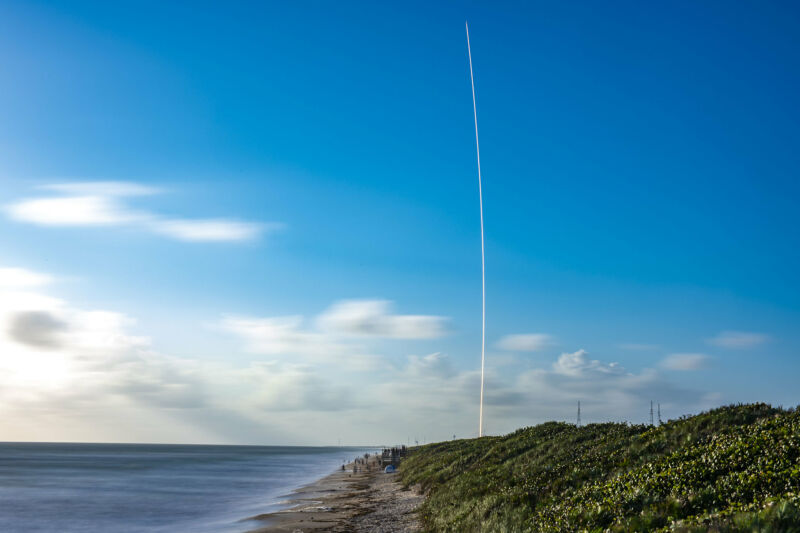With Starlink, SpaceX continues to push the bounds of reusing rockets

A Falcon 9 rocket ascended into the blue skies above Florida on Sunday morning, and much of the space world barely took notice.
Sure, it was fairly early on a Sunday, and many Americans were not even yet out of bed. But there’s a deeper reality here: SpaceX has made launching rockets almost seem routine. The company’s vice president of reliability, Hans Koenigsmann, once told me that one of his goals was to take the “magic” out of rocket launches. And the company seems to be succeeding.
SpaceX is also succeeding at reuse. Sunday morning’s launch used a Falcon 9 first stage that has already flown into space five times. This is the second time SpaceX has used a first stage a total of six times, and next year it is likely to reach ten uses of its rocket. And then there is the payload fairing. For the first time, SpaceX was able use each of these fairing halves for a third time.
For most launches, the company now typically expends only the Falcon 9 rocket’s second stage, with a single Merin vacuum engine. The photo gallery below offers some breathtaking overviews of how SpaceX returns its first stages and fairing halves to Florida by boat.
SpaceX has employed its used rockets to build out its Starlink constellation, with Sunday morning’s launch adding 60 more satellites. This was the 13th launch of “operational” satellites, bringing to 835 the number of Starlink satellites launched in a year and a half—although 45 of the demonstration version satellites launched in May 2019 have since deorbited. The company is expected to begin offering a “beta” version of its Internet-from-space program by the end of this year.
And the beat goes on. On Wednesday, October 21, the company will attempt to launch 60 more Starlink satellites from Space Launch Complex-40 in Florida. There is a 60 percent chance of favorable weather at the opening of the launch window at 12:29pm ET (16:29 UTC).
-
The 61st landed Falcon 9 nearing the end of the jetty at Port Canaveral after landing aboard ‘Of Course I Still Love You’ after the 12th operational Starlink mission.Trevor Mahlmann for Ars
-
Falcon 9 aboard OCISLY entering Port Canaveral after the 12th operational Starlink mission in early October.Trevor Mahlmann for Ars
-
Falcon 9 aboard OCISLY entering Port Canaveral after the 12th Starlink mission.Trevor Mahlmann for Ars
-
Fairing catcher ship GO Ms. Tree leading the way into Port Canaveral.Trevor Mahlmann for Ars
-
Close-up of Falcon 9 aboard OCISLY entering Port Canaveral after the 12th Starlink mission.Trevor Mahlmann for Ars
-
A panoramic view.Trevor Mahlmann for Ars
-
This was how this booster core looked after three missions. A bit sooty.Trevor Mahlmann for Ars
-
SpaceX has also begun recovering payload fairing halves.Trevor Mahlmann for Ars
-
Combined, they are worth an estimated $6 million.Trevor Mahlmann for Ars
-
Why would you not try to catch $6 million falling out of the sky, Elon Musk has reasoned.Trevor Mahlmann for Ars
A few years ago, some in the aerospace industry smirked when SpaceX founder Elon Musk attempted to brand used boosters as “flight-proven” rockets. However, this may in fact be accurate. Back on October 2, the launch of a new Falcon 9 rocket was scrubbed at T-2 seconds due to a turbomachinery issue. The GPS III payload remains on the ground, and NASA has also taken the step of delaying its Crew-1 mission to the International Space Station—also flying on a new Falcon 9 rocket—until no earlier than November 11 while this issue is investigated.
Meanwhile, the Starlink missions keep flying into orbit. If the 14th operational mission lifts off on Wednesday, it will be the third Starlink launch in October. True, these are SpaceX payloads, so the company can afford to take higher risks with its low-cost satellites. Yet with these Starlink missions, the company is proving not only that it can fly used rockets—it can also take a little of the magic away.
https://arstechnica.com/?p=1715634